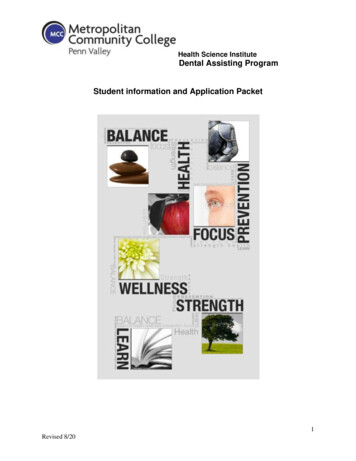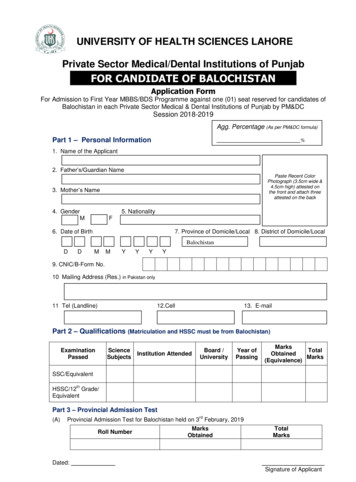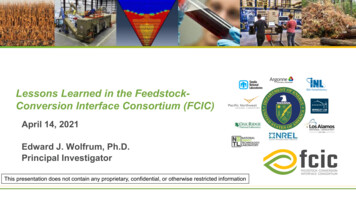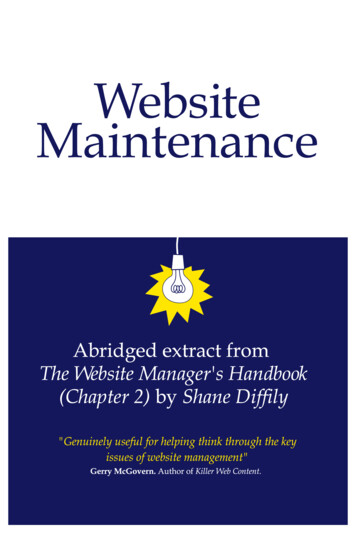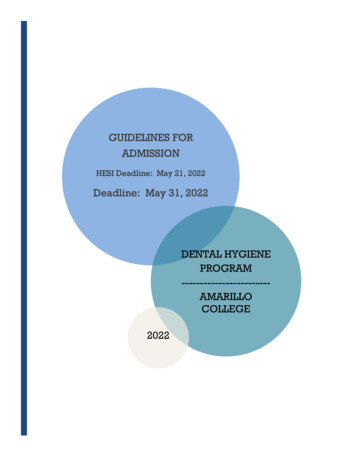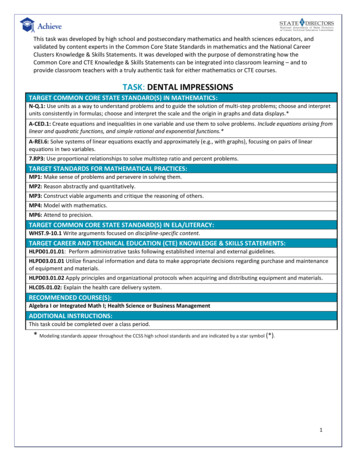
Transcription
This task was developed by high school and postsecondary mathematics and health sciences educators, andvalidated by content experts in the Common Core State Standards in mathematics and the National CareerClusters Knowledge & Skills Statements. It was developed with the purpose of demonstrating how theCommon Core and CTE Knowledge & Skills Statements can be integrated into classroom learning – and toprovide classroom teachers with a truly authentic task for either mathematics or CTE courses.TASK: DENTAL IMPRESSIONSTARGET COMMON CORE STATE STANDARD(S) IN MATHEMATICS:N-Q.1: Use units as a way to understand problems and to guide the solution of multi-step problems; choose and interpretunits consistently in formulas; choose and interpret the scale and the origin in graphs and data displays.*A-CED.1: Create equations and inequalities in one variable and use them to solve problems. Include equations arising fromlinear and quadratic functions, and simple rational and exponential functions.*A-REI.6: Solve systems of linear equations exactly and approximately (e.g., with graphs), focusing on pairs of linearequations in two variables.7.RP3: Use proportional relationships to solve multistep ratio and percent problems.TARGET STANDARDS FOR MATHEMATICAL PRACTICES:MP1: Make sense of problems and persevere in solving them.MP2: Reason abstractly and quantitatively.MP3: Construct viable arguments and critique the reasoning of others.MP4: Model with mathematics.MP6: Attend to precision.TARGET COMMON CORE STATE STANDARD(S) IN ELA/LITERACY:WHST.9-10.1 Write arguments focused on discipline-specific content.TARGET CAREER AND TECHNICAL EDUCATION (CTE) KNOWLEDGE & SKILLS STATEMENTS:HLPD01.01.01: Perform administrative tasks following established internal and external guidelines.HLPD03.01.01 Utilize financial information and data to make appropriate decisions regarding purchase and maintenanceof equipment and materials.HLPD03.01.02 Apply principles and organizational protocols when acquiring and distributing equipment and materials.HLC05.01.02: Explain the health care delivery system.RECOMMENDED COURSE(S):Algebra I or Integrated Math I; Health Science or Business ManagementADDITIONAL INSTRUCTIONS:This task could be completed over a class period.* Modeling standards appear throughout the CCSS high school standards and are indicated by a star symbol (*).1
About the Common Core State Standards in MathematicsThe Common Core State Standards (CCSS) for Mathematics are organized by grade level in grades K–8. At the highschool level, the standards are organized by conceptual category (number and quantity, algebra, functions,geometry, and probability and statistics), showing the body of knowledge students should learn in each category tobe college and career ready, and to be prepared to study more advanced mathematics. The Standards forMathematical Practice describe ways in which developing student practitioners of the discipline of mathematicsincreasingly ought to engage with the subject matter as they grow in mathematical maturity and expertisethroughout the elementary, middle and high school years. www.corestandards.orgAbout the Common Core State Standards in English Language Arts/LiteracyThe Common Core State Standards (CCSS) for ELA/Literacy are organized by grade level in grades K–8. At the highschool level, the standards are organized by 9-10 and 11-12 grade bands. Across K-12 there are four major strands:Reading, Writing, Speaking and Listening, and Language. The CCSS also include Standards for Literacy inHistory/Social Studies, Science, and Technical Subjects, with content-specific (Reading and Writing) literacystandards provided for grades 6-8, 9-10, and 11-12, to demonstrate that literacy needs to be taught and nurturedacross all subjects. www.corestandards.orgAbout the Career Cluster Knowledge and Skill StatementsAs an organizing tool for curriculum design and instruction, Career Clusters provide the essential knowledge andskills for the 16 Career Clusters and their Career Pathways. It also functions as a useful guide in developingprograms of study bridging secondary and postsecondary curriculum and for creating individual student plans ofstudy for a complete range of career options. As such, it helps students discover their interests and their passions,and empowers them to choose the educational pathway that can lead to success in high school, college and esources/clusters/health.html. Although not included in this template,all Clusters and Pathways have Foundational Academic Expectations and Essential Knowledge & Skills Statements,which, in some cases, overlap with the Common Core State Standards.KEY TERMS Gypsum powderStone modelsDigital impression technologyBreak-even point2
DENTAL IMPRESSIONS – The TaskTo fabricate a stone model from a dental impression, you need 30 mL of water to 100 grams of gypsumpowder. In your orthodontic office, in an average week, you make 75 impressions. It is most cost effective toorder the powder in 50-lb boxes. (Remember: 1 gram .0022 pounds)1. How many stone models can you make with one 50-lb box? Show your work and mathematical thinking.2. How frequently will you need to re-order your powder supply? Show your work and mathematicalthinking.3. What is your office’s annual demand for the gypsum powder? Show your work and mathematical thinking.4. Your office is considering purchasing digital impression technology, but only if it proves to be more costeffective within two years. Assuming the initial investment in technology and training for the digitalimpression scanner is 115,000, the technology will eliminate the number of manual/non-digitalimpressions by 60%, and manual impressions cost your office 30 on average, create equations todetermine your break-even point on this investment. Support your solution both algebraically andgraphically.5. Write a recommendation to your office encouraging or discouraging the purchase of the digital impressiontechnology based on your findings above.3
DENTAL IMPRESSIONS – Possible Solutions1. How many stone models can you make with one 50-lb box?Since 100 grams of gypsum powder are needed per impression, we can first determine how many 100gram units are in 50 pounds:100 grams1 impression.0022 lbs1 gramx 0.22 lbs per impressionThen to find how many impressions per 50lb box:50 lbs1 boxx1 impression0.22 lbs 227.27 impressions per boxOR if we first convert the 50-pound box into grams:50 lbsx1g.0022 lbs22, 727.27 g (in one 50-lb box)If we divide into 100-gram units we need for each impression, we get: 227.27 impressions per box227 impressions are possible using one 50-lb box of gypsum powder2. How frequently will you need to re-order your powder supply?We found that we can make 227 impressions per box and we know that the office creates 75 impressionsper week. Using dimensional analysis we find that:227 impressions1 boxx1 week75 impressions 3.03 weeks per boxThe office would need to reorder once every 3 weeks, on average. This assumes prompt delivery of yourorder and assumes that you do not want to maintain excess boxes in your inventory.3. What is your office’s annual demand for the gypsum powder?There are 52 weeks in a year, and the office must order a box every 3 weeks, therefore the office mustorder: 52 / 3 17.3The office should order 18 boxes per year.(Students should round up to ensure the office doesn’t ever run out).4
4. Your office is considering purchasing digital impression technology, but only if it proves to be more costeffective within two years. Assuming the initial investment in technology and training for the digitalimpression scanner is 115,000, the technology will eliminate the number of manual/non-digitalimpressions by 60%, and manual impressions cost 30 on average, create equations to determine yourbreak-even point on this investment. Show your work algebraically and graphically.Let x time, in yearsLet y cost, in dollarsThe student must create two equations, one for the office without the technology and one for the officewith the technology.Without Technology:The office makes 75 impressions a week for 52 weeks a year at a cost of 30.00 per impression. Thereforethe annual cost per year of impressions is:75 impressions1 weekx52 weeks1 yearx 301 impression 117,000 peryearSo the equation representing the cost per year without technology is:y 117,000xWith Technology:The office still must make 40% of impressions manually (at the cost of 30 per impression). The officemakes 75 impressions a week, at 52 weeks a year so the number of impressions per year is:75 x 52 3900 impressions per yearThe office now only needs to manually make 40% of this amount, therefore40% of 3900 0.4 x 3900 1,560 impression will be made manually.At 30 an impression the annual cost for manual impressions would now be:1,560 x 30 46,800Therefore, the equation will be the total cost of the technology plus 46,800 each year:y 46,800x 115,000To solve for the break-even point we can solve the system of equations:y 117,000xy 46,800x 115,000117,000x 46,800x 115,00070,200x 115,000x 115,000/70,200 1.64 years or approximately 1 year, 8 months5
Therefore, the break-even point on this investment will be after 1.64 years, or approximately 1 year, 8months.The student must also solve graphically and show the intersection point. (This graph was created using theonline graphing calculator tool: Meta-Calculator.)5.Write a recommendation to your office encouraging or discouraging the purchase of the digital impressiontechnology based on your findings above.Answers may vary, but the investment in the digital impression technology pays off after 1.64 years, or inabout 1 year and 8 months, making it cost effective within two years. It is, therefore, a cost effectivedecision for the office to purchase this technology if they are planning to use it for 2 years or more.6
DENTAL IMPRESSIONS - Possible ExtensionsThe extensions below represent potential ways in which mathematics and/or CTE teachers can build on thetask above. All of the extensions are optional and can be used in the classroom, as homework assignments,and/or as long-term interdisciplinary projects.1. Research additional costs associated with man-made and digital impressions (e.g., staff, maintenancecontracts, software updates) and re-calculate the cost/impression for man-made and digital impressionsand the new breakeven point.2. Research the actual costs of digital impression technology with vendors. How do the costs compare tothose described in Question 4?7
DENTAL IMPRESSIONS – Appendix: Alignment RatingsThe rating system used in the following charts is as follows:3EXCELLENT ALIGNMENT:The content/performance of the task is clearly consistent with the content/performance of the Common Core State Standard.2GOOD ALIGNMENT:The task is consistent with important elements of the content/performance of the CCSS statement, but part of the CCSS is not addressed.1WEAK ALIGNMENT:There is a partial alignment between the task and the CCSS, however important elements of the CCSS are not addressed in the task.N/A:For Mathematical Practices a content rating does not apply.In the charts C Content Rating and P Performance Rating COLOR KEYBlack Part of CCSS/K&S Statementaligned to taskGray Part of CCSS/K&S Statement notaligned to task8
Task-to-Mathematical Practice Alignment Recording SheetTaskNameAligned CCSSMathematical Practice StandardsDENTAL IMPRESSIONSMP1: Make sense of problems andpersevere in solving them.MP2: Reason abstractly andquantitatively.MP3: Construct viable argumentsand critique the reasoning of others.MP4: Model with mathematics.MP6: Attend to precision.CN/AN/AN/AN/AN/AP3Alignment Comments(Standards selection, partial alignments, reasons for rating, etc)For this task students analyze givens, constraints,relationships, and goals. They must make conjecturesabout the form and meaning of the solution and plan asolution pathway. They must check the reasonableness oftheir solution, continually asking themselves, “Does thismake sense?” While the task requires routine math, thestudent must persevere to answer all 5 questions.2This task involves quantitative relationships. It requiresthat students make sense of quantities and theirrelationships in the problem situation. They must attend tothe meaning of the quantities and pay attention to units asthey represent the quantities in their solution pathway.While strong quantitative reasoning is required, the tasklacks expectations for abstraction.2Students are asked for a written recommendation basedon their mathematical findings, but are not asked tocritique the reasoning of others.3This task requires that students translate constraints intoequations and extract information from both the algebraicsolution and the graph.3Students must use precise units of measure, convert units,label the axes, and perform calculations precisely.Rounding and estimation are a key part of the thinking thatstudents must use to accurately answer the questions.Students need to calculate accurately and express answerswith a degree of precision appropriate for the problem.Task Comments(Strengths, weaknesses,possible improvements,effectiveness, etc)This is a multi-stageproblem with real lifeapplications andconsiderations.Students must identifyquantities and othermeasures to determinecosts, using practicalsituations, andaccurate quantitativecalculations. They mustsupport theirreasoning at each stepof the process andmake arecommendationbased on theirfindings.9
Task-to-Common Core State Standards Alignment Recording SheetDENTAL IMPRESSIONSTaskNameAlignment CommentsAligned CCSSContent StandardsCPNQ1: Use units as a way to understand problems andto guide the solution of multi-step problems; chooseand interpret units consistently in formulas; chooseand interpret the scale and the origin in graphs anddata displays.*33Throughout the task, students must use units toreach conclusions and to support their results.(Standards selection, partial alignments, reasons forrating, etc.)A-CED1: Create equations and inequalities in onevariable and use them to solve problems. Includeequations arising from linear and quadratic functions,and simple rational and exponential functions.*23Question 4 requires a system of equations to becreated and used to answer the questions thatfollow. There are no inequalities used in thistask. Equations are limited to linear equations.A-REI.6: Solve systems of linear equations (e.g., withgraphs) exactly and approximately, focusing on pairsof linear equations in two variables.33Students are asked to solve the system of linearequations algebraically and graphically.3Proportional relationships are used throughoutthe task in the dimensional analysis required toanswer the rate questions. Percentage is usedin Question 4.7.RP3: Use proportional relationships to solvemultistep ratio and percent problems.3Task Comments(Strengths, weaknesses,possible improvements,effectiveness, etc.)This complex real-worldtask combines systemsof equations andcalculation with workshown to supportresults.* Modeling standards appear throughout the CCSS high school standards and are indicated by a star symbol (*).10
Task-to-National Career Cluster Knowledge & Skills Statements Alignment Recording SheetDENTAL IMPRESSIONSTaskNameAligned National Career Cluster Knowledge &Skills StatementsHLPD01.01.01: Perform administrative tasksfollowing established internal and externalguidelines.HLPD03.01.01 Utilize financial information anddata to make appropriate decisions regardingpurchase and maintenance of equipment andmaterials.HLPD03.01.02 Apply principles andorganizational protocols when acquiring anddistributing equipment and materials.HLC05.01.02: Explain the health care deliverysystem.CPAlignment Comments11Working with vendors/identifying orders to placeis an assumed part of the task scenario.2.53The task utilizes financial information to makedecisions and is enhanced in the extensionthrough addressing the maintenance component.33The task requires students to assess and offerrecommendations about resource allocation.1The task requires students to predict how factorssuch as costs influence the decision is present.The extensions provide a stronger demonstrationof this expectation.1Task CommentsThe context of the taskprovides an integratedunderstanding of bothHealth Sciences andsome business decisionprinciples to support adeeper integrationacross content areas.11
DENTAL IMPRESSIONS - The Task To fabricate a stone model from a dental impression, you need 30 mL of water to 100 grams of gypsum powder. In your orthodontic office, in an average week, you make 75 impressions. It is most cost effective to order the powder in 50-lb boxes. (Remember: 1 gram .0022 pounds) 1.


